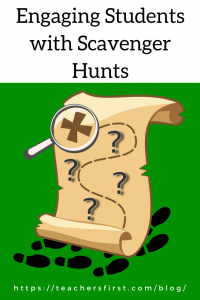 You might not know that August 19 is Geocaching Day. Geocaching is an outdoor treasure hunt where players use GPS devices to find hidden containers located around the world. Hidden locations vary from easy to find areas to those that are more isolated and involve planning and preparation to access the site. Items found in the containers vary but sometimes include a journal or small items such as a key chain, pencils, or similar souvenir. There is a large group of enthusiastic participants in the “sport” of geocaching. They love this activity because it engages them with active exploration, involves collaboration and group work, and offers many ways to learn through problem-solving. Learn more about Geocaching in this informative article.
You might not know that August 19 is Geocaching Day. Geocaching is an outdoor treasure hunt where players use GPS devices to find hidden containers located around the world. Hidden locations vary from easy to find areas to those that are more isolated and involve planning and preparation to access the site. Items found in the containers vary but sometimes include a journal or small items such as a key chain, pencils, or similar souvenir. There is a large group of enthusiastic participants in the “sport” of geocaching. They love this activity because it engages them with active exploration, involves collaboration and group work, and offers many ways to learn through problem-solving. Learn more about Geocaching in this informative article.
What does that have to do with education and teaching? This engaging activity offers inspiration for planning educational activities that allow students the opportunity to become involved in their learning through exploration and personal reflection, similar in style to geocaching.
Fortunately, teachers have several different tools that lend themselves to treasure/scavenger hunt activities. These tools use a variety of technologies to support learning objectives while allowing students flexibility in the learning process.
Let’s start with Flipgrid (TeachersFirst review). Flipgrid is a very popular video response tool; in fact, you may already have #FlipgridFever! One method of using Flipgrid is known as a Fliphunt; a Fliphunt is an online scavenger hunt using Flipgrid to post directions and student responses. Learn more about Fliphunts at the Flipgrid blog. Some ideas for Fliphunts include:
- Ask students to find and record examples of geometric shapes found around the school, classroom, or at home.
- As part of a unit on states of matter, find examples of the three states of matter. Record a video showing the example and describing the characteristics that identify its states.
- Use a Fliphunt to create a classroom community as a back to school activity. Create a list of ideas for students to find through discussions with fellow students. Suggestions include finding someone who went to a different state over the summer, find someone who participates in your favorite sport, or find a student who has lived in a different country.
- As part of a novel or book study, create a list of story elements and ask students to identify them within their reading material through a video discussion.
Another scavenger hunt creation tool is Goosechase (TeachersFirst review). Goosechase creates digital scavenger hunts for teams or individuals. Create game missions on the Goosechase site and add missions for participants to earn points. Options for submitting mission items include photos, videos, text, or by checking in at a location. One benefit of using Goosechase is the ability to create and monitor ongoing scavenger hunts that fit within your required parameters. Goosechase includes an extensive game library to use or modify as needed, here are some examples of activities found in the game library:
- Constitution Review – this scavenger hunt challenges students to take photos, create sketch notes, act out scenarios, and more to explore the role of the Constitution in daily life.
- Family Science Night – this hunt demonstrates how to use a scavenger hunt as a passport for students and families to participate through a variety of missions. The missions include taking pictures, constructing bridges, and participating in several science experiments.
- Gettysburg Field Trip – instead of providing students a paper list of items to look for during a field trip, this Goosechase activity offers a series of missions for students to locate during their field trip. Students document completion of the missions through pictures and responses to multiple-choice questions.
Although geocaching may not be practical for many classroom situations, the idea of participation in scavenger hunts is an excellent way to bring a variety of learning activities into any classroom. These tools provide instructors the ability to offer students’ choice, flexibility, and the opportunity to present their perspective on content. It allows teachers an insight into student perspectives on the subject, making them perfect for use as both formative and summative assessments.
Have you tried using scavenger hunts as a teaching tool? We would love to hear your ideas and tips in the comments below.


This is awesome! A great way to keep kids active and engaged. Also nice to get outside weather permitting!